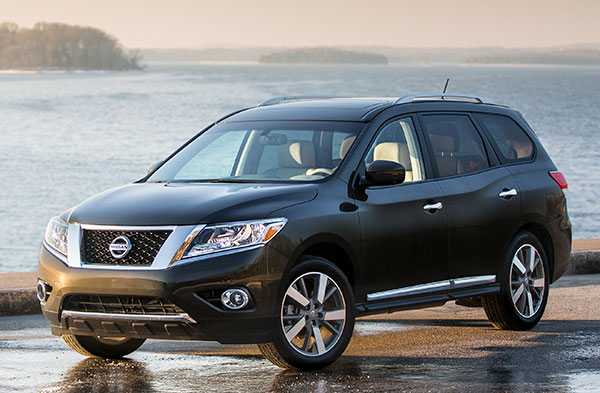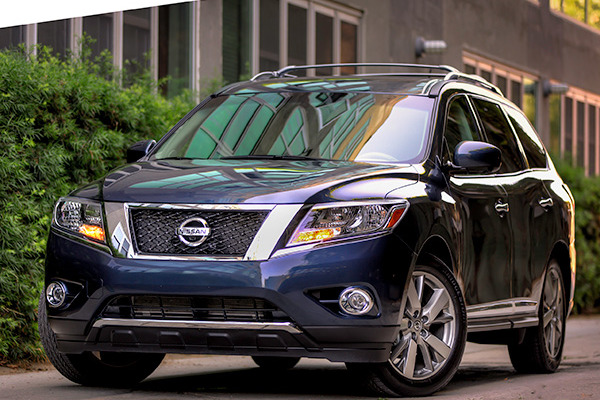

an account. You can:
Access your saved cars on any device.
Receive Price Alert emails when price changes,
new offers become available or a vehicle is sold.


Model Overview of The Nissan Pathfinder's For Sale in Middletown, CT
2016 Nissan Pathfinder Information
2016 Nissan Pathfinder
The Nissan Pathfinder is a three-row, seven-seat, midsize front-wheel-drive SUV that became a crossover for 2013, by chucking its chassis that previously came from the rear-wheel-drive pickup truck. So today its more comfortable than it is tough, down to its very crossover-ish continuously variable transmission, which takes on the SUV challenge by using an internal chain rather than belt.
The CVT is programmed to feel like an automatic transmission by shifting in steps, and this eliminates much of the high-rev annoyance of a continuously variable transmission. However we found a long delay when you floor the superb 3.5-liter V6 engine and ask for all of its 260 horsepower. An available tow package enables it to pull 5000 pounds, with the CVT making adjustments for the weight.
Pathfinder is available with all-wheel drive.
The Pathfinder is spacious and flexible, longer than a Honda Pilot and Toyota Highlander, and shorter than the Chevy Traverse, about the same length as a Ford Explorer or Mazda CX-9. It weighs less than some of its rivals, including the Traverse and Buick Enclave, and although its still hefty, it handles more like a sedan than a truck, thanks to the tuning of its hydraulic-electric steering. And the ride is refined. It has less ground clearance than the Subaru Outback, but it takes on rutted roads with confidence.
The EPA rates the Pathfinder at 20/27/23 miles per gallon City/Highway/Combined with front-wheel drive, one less mpg with all-wheel drive. The fully equipped and heavier Platinum model gets 21 mpg Combined.
With six airbags standard, the NHTSA gives the Pathfinder five stars overall, with four stars in the categories of front impact and rollover. The IIHS gives it the best Good rating in all of its categories. Rearview camera is not standard.
2014 Nissan Pathfinder Information
2014 Nissan Pathfinder
A fixture in Nissan's product lineup for more than 25 years, the fourth-generation Pathfinder has evolved from the cheeky adolescent Hardbody of 1986 to the mature parental unit of 2013-14. It's a maturation process that entailed several zigs and zags. Like so many vehicles that came along in the mid-'80s SUV boom, that first generation was a body-on-frame design based on Nissan's compact pickup truck. The next iteration (1996) was a unibody (frame rails integrated with the body shell), but Nissan reverted to body-on-frame for generation three (2005).
As a result, the transition to the 2013 Nissan Pathfinder, redesigned as generation four, was a major course change for this persistently popular SUV. The third generation was conceived for the possibility, however remote, of serious off-road use; hence, lots of ground clearance and body-on-frame construction.
Generation four represents an about-face. Concluding that the large-SUV segment is increasingly composed of buyers whose priorities don't include off-road adventure, Nissan retuned the Pathfinder around family values: roominess, comfort and, paramount among today's vehicle attributes, fuel economy. The result is a Nissan Pathfinder that's bigger than the gen-three model, with more room, sharply reduced curb weights, and dramatically improved fuel economy ratings.
Beneath the 2014 Nissan Pathfinder hood sits a 3.5-liter V6 engine that makes 260 horsepower and 240 pound-feet of torque, driving an Xtronic continuously variable transmission (CVT).
Biggest news for 2014, though, is the introduction of a Pathfinder Hybrid model, offered with either two-wheel or all-wheel drive. In the Hybrid, a supercharged 2.5-liter four-cylinder gasoline engine mates with a 15-kW electric motor and a compact lithium-ion battery. The battery fits under the third-row seat, which means no compromise in passenger seating or cargo space.
The new 2014 Pathfinder Hybrid uses a Nissan Intelligent Dual Clutch System. With combined output of 250 horsepower and 243 pound-feet of torque, performance is claimed to be equivalent to the non-hybrid Pathfinder's 3.5-liter V6. The Hybrid comes in SV, SL or Platinum trim, whereas regular Pathfinders are offered in four trim levels.
For regular 2014 Pathfinders, a new SL Tech Package includes a Bose 13-speaker premium audio system, navigation with voice recognition and XM NavTraffic/Weather, Bluetooth streaming audio, and an 8-inch touchscreen.
How did the current-generation Pathfinder increase dimensions while reducing weight? That, plus much higher chassis rigidity, is a benefit of unibody construction. At 114.2 inches, the current Pathfinder's wheelbase is 2.0 inches longer than the 2012 model. Overall length stretched 4.6 inches, and width expanded from 72.8 to 77.2. The only dimension that shrunk was height, partly because ride height and ground clearance (6.5 inches) are similar to sedan figures.
This isn't surprising, since the latest Pathfinder's architecture, based on front-wheel drive, is shared with the Nissan Altima sedan. What does surprise is how much mass was pared from the Pathfinder in the transition from generation three to generation four: 300 to 500 pounds, depending on model.
Although Nissan created no fancy name for it, the design and engineering approach to the weight reduction is similar to Mazda's Skyactiv Technology. Everything in the new Pathfinder went on a diet.
The sum of the foregoing, plus improved aerodynamics (0.34 coefficient of drag, very good by SUV standards), is EPA fuel-economy estimates of 20 mpg City, 26 Highway for front-wheel drive models; or 19/25 mpg with all-wheel drive. Nissan has claimed best-in-class status for the front-drive Highway rating. In contrast, the prior Pathfinder rated only15/22 mpg with rear drive, 13/18 with four-wheel drive.
The net result is a seven-passenger crossover SUV that's stylish, roomy, quiet, and economical by midsize-SUV standards. That group includes the Chevrolet Traverse, Ford Explorer, Honda Pilot, Mazda CX-9, and Toyota Highlander.
Reaching past the regular Pathfinder's credentials, the new 2014 Nissan Pathfinder Hybrid delivers an even more satisfying midsize-SUV experience, while earning a truly thrifty EPA estimate: 25 mpg City/28 mpg Highway (27 mpg Highway with all-wheel drive).
2013 Nissan Pathfinder Information
2013 Nissan Pathfinder
A fixture in Nissan's product lineup for more than 25 years, the fourth generation Pathfinder has evolved from the cheeky adolescent Hardbody of 1986 to the mature parental unit of 2013. It's a maturation process that has entailed several zigs and zags. Like so many of the vehicles that came along in the mid-'80s SUV boom, that first generation was a body-on-frame design based on Nissan's compact pickup truck. The next iteration (1996) was a unitbody (frame rails integrated with the body shell), but Nissan reverted to body-on-frame for generation three (2005).
As a result, the transition to the 2013 Nissan Pathfinder, generation four, is a major course change for this most persistently popular of all Nissan SUVs. The third generation was conceived for the possibility, however remote, of serious off-road use, hence lots of ground clearance and body-on-frame construction, a prescription for enduring the pounding that goes with rugged terrain.
Generation four represents an about-face. Concluding that the large SUV segment is increasingly composed of buyers whose priorities don't include off-road adventure, Nissan has retuned the 2013 Pathfinder around family values: roominess, comfort, and, paramount among today's vehicle attributes, fuel economy.
The result is that the 2013 Nissan Pathfinder is bigger than the gen three Pathfinder, with more room, sharply reduced curb weights, and dramatically improved fuel economy ratings.
Increased dimensions and reduced weight? Yes. That, and much higher chassis rigidity, is the benefit of unitbody construction. At 114.2 inches, the new Pathfinder's wheelbase is 2.0 inches longer than the 2012 model, overall length stretches 4.6 inches to 197.2, and width expands from 72.8 to 77.2. The only dimension that shrinks is height: 69.6 inches, down 2.4, in part because ride height and ground clearance (6.5 inches) is similar to that of an everyday sedan.
This isn't surprising, since the 2013 Pathfinder's architecture based on front-wheel drive is shared with the Nissan Altima sedan and the new Infiniti JX sport-utility. What is surprising is just how much mass has been pared from the Pathfinder in the transition from gen three to gen four: 300 to 500 pounds, depending on trim level and whether the vehicle is equipped with four-wheel drive.
Although Nissan doesn't have a fancy name for it, the design and engineering approach to the weight reduction is pretty much the same as Mazda's Skyactiv Technology. Everything in the new Pathfinder went on a diet. As you'd expect, the biggest weight loss was achieved by the change to unibody construction, about 32 percent, according to Nissan. The new 3.5-liter V6 engine and continuously variable transmission (replacing the previous 4.0-liter V6 and conventional 5-speed automatic) accounted for another chunk, but just about every conceivable element of the car has been trimmed: dashboard, seats, door panels, interior trim elements, you name it.
The sum of the foregoing, plus improved aerodynamics (0.34 coefficient of drag, very good by SUV standards), is EPA fuel economy ratings of 20 mpg City, 26 Highway for front-wheel drive models, 19/25 mpg with all-wheel drive. Nissan claims best in class for the front-drive Highway rating. More significant, the outgoing Nissan was rated for 15/22 with rear drive, 13/18 with four-wheel drive.
The net is a seven-passenger crossover SUV that's stylish, roomy, quiet, and economical by the standards for the mid-size SUV class, a class that includes the Chevrolet Traverse, Ford Explorer, Honda Pilot, Mazda CX-9, and Toyota Highlander.


